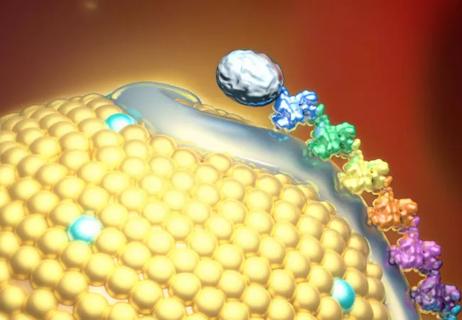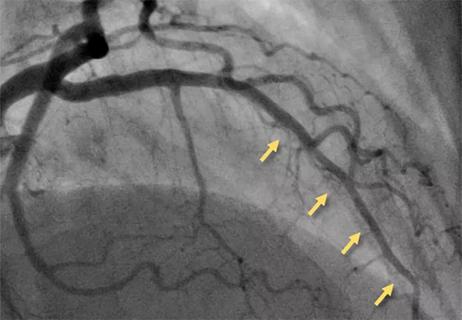Phase 2 trial of zerlasiran yields first demonstration of longer effect with each dose of an siRNA

Results of the latest phase 2 trial of a small-interfering RNA (siRNA) reveal that the agent produced cumulative reductions in elevated lipoprotein(a), or Lp(a), levels after several doses. The siRNA, known as zerlasiran, reduced time-averaged Lp(a) concentrations by more than 80% across 36 weeks of treatment in the randomized ALPACAR-360 trial.
Advertisement
Cleveland Clinic is a non-profit academic medical center. Advertising on our site helps support our mission. We do not endorse non-Cleveland Clinic products or services. Policy
“This is the first time that time-averaged Lp(a) reduction has been reported from a trial of an siRNA therapy,” says Steven Nissen, MD, who presented the results in a late-breaking science session at the American Heart Association Scientific Sessions 2024 and is first author of the study report published simultaneously in JAMA. “We are still learning how the siRNA therapies affect lipoprotein(a) during extended treatment. This trial shows for the first time that with each successive dose, Lp(a) reduction endured longer and waned more slowly. This has implications for the design of phase 3 trials of zerlasiran and potentially for optimal dosing of other drugs in this class.”
Zerlasiran is among several medications in clinical trials for reduction of elevated Lp(a), a genetically determined risk factor for atherosclerotic cardiovascular disease (ASCVD) that is resistant to traditional preventive therapies, including statins. No pharmacotherapies have been approved for Lp(a) reduction.
The investigational therapies furthest in development are four nucleic acid therapeutics, consisting of the antisense oligonucleotide pelacarsen and three siRNAs, including zerlasiran. “Identifying the best dosing strategy for siRNA therapies is difficult because they all have prolonged durations of action that range from weeks to months,” says Dr. Nissen, Chief Academic Officer of Cleveland Clinic’s Heart, Vascular and Thoracic Institute, who is involved with clinical trials of three of the four nucleic acid therapeutics. “Along with assessing the safety of zerlasiran, ALPACAR-360 was designed to help identify the best dose and dosing frequency to guide a phase 3 trial.”
Advertisement
The study involved 180 adults with stable ASCVD from 26 sites in Europe, Australia and South Africa. All patients had a serum Lp(a) concentration of at least 125 nmol/L, a threshold that confers increased cardiovascular risk. The cohort was 74% male and 86% white, with a mean age of 63.7 years and a median baseline Lp(a) of 213 nmol/L (interquartile range, 177-282).
Patients were randomized in a double-blind manner to one of five treatment groups:
Doses were injected subcutaneously in the abdomen. Patients were followed every four weeks up to 40 weeks and then at weeks 48 and 60 after randomization.
The primary endpoint was the time-averaged percentage change in serum Lp(a) from baseline through 36 weeks after first administration. Time-averaged percentage changes from baseline to weeks 48 and 60 were secondary endpoints, as were safety and tolerability through 60 weeks.
The Cleveland Clinic Coordinating Center for Clinical Research (C5Research) performed statistical analysis and helped manage the trial.
Of the 180 patients randomized, 178 received study doses and were included in results analyses. Compared with the pooled placebo groups, mean time-averaged percentage changes in Lp(a) concentrations through 36 weeks were:
Advertisement
Median percentage changes at week 36 were:
Injection-site reactions were the most common treatment-related adverse effects; mild pain at the site was reported by 2.3% to 7.1% of participants within the first day after injection. No such reactions led to study withdrawal or missed doses, and no treatment-related serious adverse events occurred.
“This is the first trial of a nucleic acid therapy to use time-averaged Lp(a) reduction as an endpoint,” Dr. Nissen observes, noting that other trials used maximal reduction or reduction at a given time point. “Our endpoint more accurately reflects the effect of treatment over time, including the intervals between doses.
“We saw that, with each successive dose, the duration of reduction was longer and the waning of Lp(a) lowering was attenuated,” he continues. “In the group that received three doses of zerlasiran 300 mg, the median reduction at the 60-week final follow-up visit was still 58.8%. This was a full 28 weeks after the last of the three doses had been given.”
He adds that any such effect hadn’t been appreciated in previous trials of nucleic acid therapies because they have involved either single doses or agents that are dosed too frequently — such as every 4 or 12 weeks — to adequately gauge the effect on Lp(a) rebound.
“The cumulative effect we observed with successive doses will inform the dosing interval chosen for phase 3 studies of zerlasiran,” Dr. Nissen says. To that end, the study report includes waterfall plots that reveal responses to therapy on a patient-by-patient basis. The plot for patients who received a dose every 16 weeks showed consistent responses to therapy with zerlasiran 300 mg, suggesting that dosing every 16 weeks may provide more uniformly substantial reduction across all patients compared with dosing every 24 weeks.
Advertisement
“The question that naturally arises is how much Lp(a) reduction is enough,” Dr. Nissen says. That answer is awaiting results from ongoing outcomes-based phase 3 trials of three agents — pelacarsen and the siRNAs olpasiran and lepodisiran.
“The collective research community is taking a lot of shots on goal to finally address the morbidity and mortality from Lp(a) elevation,” Dr. Nissen concludes. “We are hopeful at least one of them will end up in the back of the net soon.”
“It is exciting to have so many drugs in development to lower Lp(a),” adds Leslie Cho, MD, Co-Section Head of Preventive Cardiology and Rehabilitation at Cleveland Clinic. “We look forward to results from phase 3 studies to tell us whether lowering Lp(a) in the era of aggressive LDL control reduces cardiac events.”
The trial was funded by Silence Therapeutics, which is developing zerlasiran. Dr. Nissen reported coordinating center funding from Silence Therapeutics, Novartis and Eli Lilly during the conduct of the trial.
Advertisement
Advertisement

Yet 21.4% of tested individuals had Lp(a) elevation

Small interfering RNA lowered lipoprotein(a) by 94% during six-month follow-up after a single dose

It's time to increase testing for this major cardiovascular risk factor in advance of new therapies

Undetectable levels achieved for nearly nine months in phase 1 trial

First-in-human phase 1 trial induced loss of function in gene that codes for ANGPTL3

Proteins related to altered immune response are potential biomarkers of the rare AD variant

Phase 3 TANDEM study may help pave way to first approval of a CETP inhibitor

Resourceful approaches to the care of patients with microvascular disease and elevated Lp(a)